Il-28 front-line bomber
8 July 2013 turned 65 years since the first flight of the Il-28 jet bomber.
Creating an aircraft of this class became possible due to the fact that in the USSR 1947 in the USSR they launched into a licensed mass production reliable, long-life, English turbojet engine with a Nin centrifugal compressor, which develops take-off thrust 2270 kgf. The ability to use for the protection of the bomber only one mobile defensive installation and identified the main layout features of the IL-28. Thus, its design "began with a tail."
IL-28 was created under the crew of three people: a pilot, navigator and stern gunner-radio operator. When deciding to abandon the co-pilot when designing, the relatively short duration of the flight of a front-line bomber was taken into account, which was on average 2,0-2,5 hours and did not exceed 4 hours. The work of the pilot in a cruise flight was supposed to be facilitated by the installation of the autopilot. The crew of IL-28 was located in the front and rear sealed cabins. The high speed of the IL-28 required the adoption of special measures to ensure emergency escape. The workplaces of the pilot and navigator were equipped with ejection seats. In an emergency, the radio operator-gunner could use the lower access hatch, the lid of which was opened to protect it from the action of the air flow at the moment of separation from the aircraft. The navigator was in the ejection seat during takeoff, landing, and air combat. When working with a bomber sight, he took a seat on another seat located on the starboard side of the aircraft. For the convenience of firing and tracking the target, the shooter moved vertically along with weapons.
The adopted defensive armament scheme and the composition of the crew made it possible to sharply reduce the geometrical dimensions of the IL-28 compared to the IL-22 developed earlier.
The big midsection of the Nin TRD (in the series received the name TRD RD-45F) and the desire to prevent foreign objects from being sucked from the unpaved runways led to the abandonment of the engine pylons and their installation in the engine nacelles, tightly pressed to the lower wing surface.
IL-28 had a direct wing, composed of new high-speed profiles CP-5, developed at TsAGI. Equipped with a simple single-slit flap, this wing provided good take-off and landing characteristics, necessary for basing on poorly prepared ground airfields with a limited runway length. The wing IL-28 had a technological connector along the plane of the chords along the whole span. In addition, each half was divided into a number of panels, which included all the elements of the longitudinal and transverse set. This made it possible to significantly expand the scope of work, improve the working conditions of workers and replace in mass production the manual riveting machine press.
To ensure the required stability and controllability characteristics over the entire range of flight speeds on the IL-28, it was decided to install swept tail with symmetrical profiles.
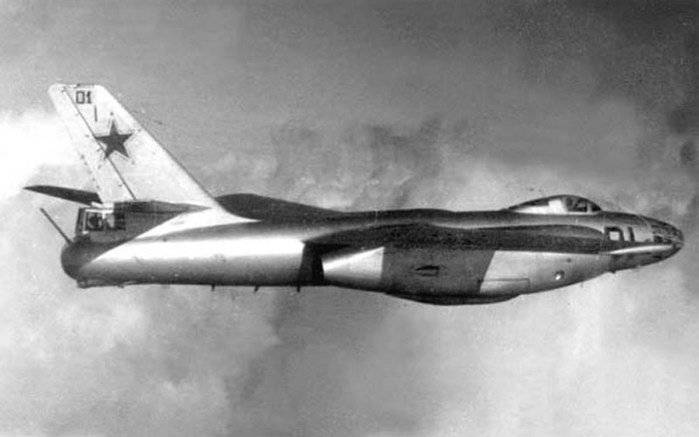
In order to simplify maintenance and reduce the cost of production, a longitudinal process connector was made on the fuselage. This solution allowed the mechanization of riveting and assembly work and, for the first time in the practice of domestic aircraft construction, provided open approaches to all elements of the fuselage design, allowing for quick installation of equipment and systems in it. All hydro and air pipelines, as well as electrical wiring, were located in channels located on both sides of the fuselage, which were closed from the outside by easily removable panels. This simplified the installation and installation of wiring, and in operation allowed for quick and high-quality control of its condition, it was easy to replace broken individual elements, which reduced the time to prepare the aircraft for departure and, ultimately, increased its combat effectiveness.
The aircraft was equipped with an effective anti-icing system (PIC). The use of turbojet engines on the Il-28 has greatly simplified the production of large amounts of hot air and made it possible to quickly design the most efficient air-thermal PIC at that time, which had no protruding parts, characterized by high reliability, low weight and ease of operation. The system used hot air taken from engine compressors, which was sent to the air ducts along the entire span of the front edges of the wing, horizontal tail and keel. In their end fairings there were outlets through which exhaust air was discharged into the atmosphere. The system was automated and did not require the intervention of the crew in the process of regulating the air supply. The system provided protection against icing in the case of a flight with one failed engine. IL-28 turned out to be the only aircraft in the Soviet Air Forces that on a dank 9 in March 1953, in conditions of low clouds hanging over the capital with snow and rain, were able to fly at a low altitude over Red Square, giving the last military honors to JV Stalin.
The main weapons of IL-28 were bombs with a total weight of up to 3000 kg. They were located in the bomb bay, located under the center section and equipped with four cassette and one girder holders. Cluster holders could have bombs of caliber from 50 to 500 kg, and beams of a weight from 1000 to 3000 kg. The nomenclature of the bomb load consisted of high-explosive, incendiary, fragmentation, concrete-breaking and other ammunition, and later nuclear "special equipment".
The bombing was carried out by the navigator with the help of the optical sight OPB-5, which allowed automatic aiming during the bombing from horizontal flight at the mobile and stationary targets. The sight made the calculation and counting of the aiming angles, the inclination of the plane of sight, and at the right moment automatically switched on the circuit of the electric bomb rake. In order to eliminate the influence of aircraft vibrations on the accuracy of bombing, the optical system of the sight was stabilized with a gyroscope. The sight had a connection with the autopilot and allowed the navigator to aim at controlling the airplane’s maneuver on the course without taking part in the pilot’s aiming. In difficult meteorological conditions outside the visibility of the earth, the orientation, search, identification and destruction of ground targets were carried out using a PSBN radar sight (a device for "blind" and night bombing).
The Il-28 cannon armament consisted of four HP-23 guns of the 23 mm caliber. Two of them with a general 200 ammunition of shells were mounted on the sides of the bottom of the fuselage on the quick-release fasteners. Shooting from the front guns led the commander of the aircraft. Protection of the rear hemisphere was provided by the aft installation of an Il-K6 with two HP-23 guns with ammunition for 225 projectiles per barrel. IL-K6 was the first in the USSR paired electro-hydraulic remote installation.
The IL-K6 installation had right-left firing angles on 70, 40 down and 60 up. In the normal mode of operation of the drive, the weapon moved at a speed of 15-17 degrees. per second, and in the forced mode - at speeds up to 36 degrees. per second. The drive power of the IL-K6 ensured its effective use at a flight speed of more than 1000 km / h. Distinguished by its high combat effectiveness, the IL-K6 had a relatively small mass (340 kg) and the maximum external moment 170 kgm. Subsequently, the IL-KHNUMX tower was installed on other domestic aircraft.
Looking ahead, it is worth saying that the IL-28 turned out to be a very difficult goal for fighters. Training aerial battles with the MiG-15 and MiG-17 showed that it is very difficult to cope with the "twenty-eighth" fighter equipped with only guns. When attacking from the front hemisphere, a high approach speed in combination with a relatively small aiming range and the need to take into account the possibility of two stationary HP-23s falling under fire did not leave MiG pilots any chance of success. The high speed and maneuverability of the IL-28, the presence of an effective aft defensive installation allowed their crews to successfully repel attacks from the rear hemisphere. With the advent of supersonic MiG-19, the situation has not changed. The increased speed of the fighter reduced the aiming time even more, besides, the pilots of the Ilov used braking very effectively, which further reduced the time of the attack on the dogon. And only the entry into service of the MiG-19PM, equipped with a radar sight and RS-2US missiles, increased the likelihood of "victory" when intercepting the IL-28. In the NATO countries, the development of fighters went a very similar way, and even at the end of the 50-s, when there was a sufficient number of F-100, F-104 and Drakens in Western Europe, the crews of the "twenty-eighths" had many opportunities to escape them, especially at extremely low altitudes.
The design of the IL-28 was conducted by SV Ilyushin on a proactive basis, the official task for the construction of a front bomber was issued by the AN Tupolev Design Bureau.
Tupolevsky Tu-14 with comparable characteristics, it turned out much more expensive and complex, was released in a small series and entered service with the marine aviation.
The issue of adopting a front-line bomber was considered at the highest level. As Ilyushin recalled, Stalin reviewed the data presented in detail, listened to the opinions of the military and decided to adopt the IL-28. At the same time, it was decided by the Council of Ministers from 14 May 1949 g to increase the speed of the IL-28 flight to 900 km / h by installing more powerful VK-1 engines with take-off thrusts for 2700 kgf. Three months after the decision of the Council of Ministers, 8 August 1949 was the first to take off the IL-28 with the VK-1 engines, which were installed in the new engine nacelles with a strongly marked "waist" - preload at the interface with the wing. Taking into account the testimony of testers, small changes were made to the control system in order to reduce the load on the pedals, to the hydraulic system, to the chassis-release mechanism. The combat survivability of the aircraft was enhanced by installing a neutral gas filling system in the fuselage fuel tanks.
Tests have shown that IL-28 with new engines with a normal flight weight of 18400 kg has a maximum speed of 906 km / h at an altitude of 4000 m. The pilots noted that the increase in speed did not bring anything new to the piloting technique.
In August-September, the 1949 of the Il-28 with the VK-1 engines passed the control tests with a recommendation to start the series. Aircraft production was rapidly gaining momentum. Due to the simplicity and high manufacturability of the design, the release in 1949-55. in some periods reached more than a hundred IL-28 per month. Total from 1949 to 1955. In the USSR, 6316 aircraft were built.
For the creation of the IL-28 S. Ilyushin and the group of designers of the Design Bureau was awarded the Stalin Prize.
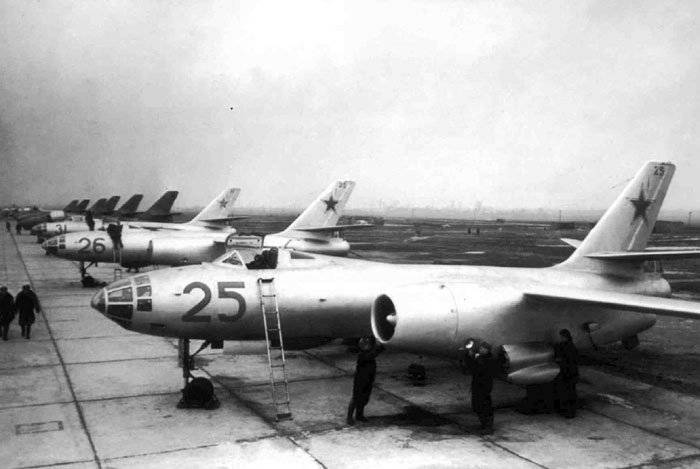
The rapid pace of mass production allowed by the middle of the 50-s. to re-equip the front-line aircraft of the new generation. Special attention was paid to the western districts. Il-28 was replaced in the front-line parts of the piston bombers Tu-2 and A-20 "Boston". In the combat regiments of the IL-28 quickly won the sympathy of ground and flight crews. Perhaps, for the first time in the Soviet Union, the creators of a combat vehicle paid so much attention to the working conditions of aviators. People accustomed to the spartan cold and noisy cabs of piston bombers, were amazed at the comfortable conditions on board the new machine, convenient layout and the wealth of equipment. The pilots particularly noted the much simpler piloting technique of the IL-28 than the Tu-2, especially during takeoff and landing, which had immeasurably increased speed and rate of climb, good maneuverability. For the navigators, the "twenty-eighth" opened previously inaccessible methods of navigation and bombing, especially in adverse weather conditions. The technical staff received the machine, which was easy and convenient to maintain: the engines were easily unpacked, the units were interchangeable, to places requiring constant monitoring, and easy access was provided.
Particularly renowned engines. Since flights at extremely low altitudes were often performed, the entry of birds into the air intakes and branches from the tops of the trees was a very common phenomenon. But, with very few exceptions, VK-1 continued to work.
When designing the IL-28, it was not supposed that there would be an atomic bomb in his arsenal. However, the growing confrontation between the two socio-political systems demanded that the car be given such an opportunity. The task was resolved by the rapid improvement of Soviet nuclear weapons, with the result that ammunition with a relatively small mass appeared. Refinement of the IL-28 was to equip the bomb compartment with a heating system, to install on board the necessary special equipment and light curtains in the cockpit. The rest of the aircraft design remained unchanged.
The divisions of nuclear bombers, deployed on the western borders of the socialist camp, looked to the "free world" as one of the embodiments of the Soviet threat. We have to admit that there was something to be afraid of. IL-28 had a high chance of delivering its cargo to its destination. The crews of aircraft carriers were selected and prepared very carefully. Each was assigned “personal”: the main and several reserve targets, which were nuclear weapons depots, air bases, etc. objects. Basing IL-28 in Poland and the GDR allowed to reach the shores of the English Channel.
At the height of the Caribbean Crisis, bombers were stationed in Cuba, at airfields in the western and eastern ends of the island. All in all, 90's Ilyushin bomber brought 42 to these bases, located 28 miles off the coast of Florida. In the operation “Mongoose”, which was carried out according to the idea of N. S. Khrushchev, they were assigned a secondary role, and missiles were considered the main trump card. Nevertheless, IL-XNUMX remained on the list of offensive weapons capable of delivering nuclear strikes on US territory.
Fortunately, the nuclear standoff of the superpowers did not result in a "hot" war. But the real atomic bombs with IL-28 were still dropped. This was done by the crews of an air unit based on Novaya Zemlya and taking part in tests of nuclear weapons conducted there.
At the beginning of 60-x, on the initiative of N.S. Khrushchev began the massive decommissioning of IL-28. Airplanes with a total of 10 hours of flying on 60-100, barbarically destroyed, and the air part was reduced. At that time, under the influence of the domination of the nuclear missile doctrine, the opinion was affirmed that manned aircraft lost their significance. The fate of thousands of airmen who were fired from the Armed Forces were crushed cruelly. The Air Force was lucky to stay a little. Veterans who have gone through this, and now with pain remember how they buried their dream, how with tears in their eyes they parted with their beloved plane, saying goodbye to him, as if with a reliable and loyal companion.
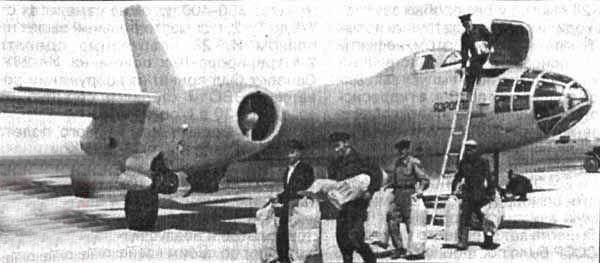
At this time, part of the Il-28 being decommissioned was prepared for the needs of the Civil Air Fleet. They dismantled weapons and sighting equipment. The aircraft had the designation IL-20 or IL-28P. They conducted training for the flight, technical staff and service personnel of various ground services for the operation of jet aircraft. The planes transferred to Aeroflot were used for regular transportation of mail and cargoes on these machines.
Destroying thousands of all-metal bombers was harder than mangling human fates. In addition, the Air Force commanders treated this vandalism without enthusiasm. Many IL-28 were converted into flying targets, even more mothballed in open parking. Quite a lot of combat vehicles got into flight schools, where they, along with the IL-28, served until the middle of the 80's. Until that time, the Il-28 target towers continued to be actively exploited. Individual units and squadrons numbering 4-10, and sometimes more machines of this modification, were available in almost all districts and groups of troops. A lot of IL-28 is preserved in combat regiments, including carriers of nuclear weapons. In some parts, they were exploited up to retraining for Su-24.
IL-28 found wide distribution outside the USSR. They were in service with the Air Force or Navy of Algeria, Afghanistan, Bulgaria, Hungary, Vietnam, GDR, Egypt, Indonesia, Iraq, Yemen, China, North Korea, Morocco, Nigeria, Poland, Romania, Syria, Somalia, Finland, Czechoslovakia. The aircraft were built serially in the People's Republic of China and Czechoslovakia. In 50's a significant amount of IL-28 was supplied to China.
After the deterioration of relations between the USSR and the People's Republic of China at the aircraft plant in Harbin, the repair of IL-28 was organized, as well as the manufacture of spare parts for them. With 1964, there began the development of mass production of the bomber, which received the designation H-5 (Harbin-5) in the Chinese Air Force. The first production vehicle took to the air in April 1967. In September of the same year, the H-5 version of a nuclear weapon was created.
Shortly after the adoption of the IL-28 were deployed on the border with the DPRK Chinese airfields. There is no official information about the use of aircraft of this type in combat. Recently it was reported that a special reconnaissance aviation group, commanded by Hero of the Soviet Union, Lieutenant Colonel N. L. Arsenyev, participated in the conflict.
The pilots made almost half of the sorties at night, participating in combat operations until the end of the war. It is worth noting that in the 1953 year (perhaps earlier), the pilots carried out not only reconnaissance missions, but also bombed. According to unconfirmed information, during the raids two IL-28 was lost.
The next conflict, where Il-28 was noted, was the “Suez crisis” 1956. A year before these events, Egypt bought Czechoslovakia around 50-Ilov.
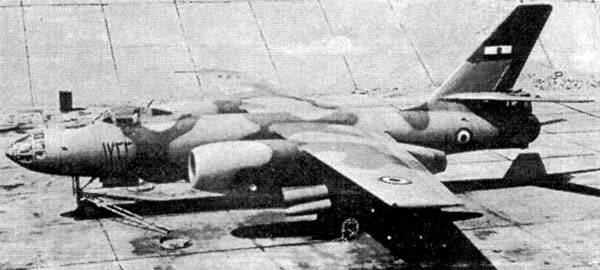
With the onset of the crisis, Egyptian bombers made several raids on enemy targets. Il-28 Egyptian Air Force also performed a few night reconnaissance.
In 1962, Ilyushin's bombers appeared in the sky of Yemen, where the monarchy was overthrown and a civil war began, which lasted until 1970. Il-28 squadron entered the Egyptian military contingent sent to help the Republicans. At the same time, the Yemeni Air Force received a batch of Ilov directly from the USSR, in which, as noted in the Western press, Soviet crews also carried out combat missions. The work of IL-28 consisted of bombing strongholds, communications and locations of monarchist detachments, as well as conducting tactical intelligence. Cases of bombardment of Saudi cities Zahran and Najran bordering Yemen were noted. In June, 1966 took place with a single IL-28 raid, accompanied by several MiG-17 air forces of the UAR to the Saudi Khamis-Mushayt air base and reconnaissance flights in the area of the Jizan port. After the beginning of the next Arab-Israeli war in June 1967, all Egyptian units were forced to leave Yemen.
On the eve of the six-day war (5.06 - 10.06.1967), the Arab countries that took part in the battles had the following IL-28 fleet: Egyptian Air Force -35-40 vehicles, which were equipped with four bomber and one reconnaissance squadron, Syria - 4-6 planes, African planes - 10 machines. The Israelis, who considered the Egyptian Il-28 and Tu-16 the main threat to their country, outlined their airfield bases as their primary objectives in the planned series of air strikes. 5 June Israeli aviation on the airfields of Ras Banas and Luxor burned 28 Egyptian IL-28. Another bomber of this type and an escort fighter were shot down by the 7 Miras of June while attempting to strike at El-Arish. Syrian Air Force lost two silt on the ground.
During the "positional war" (1967-70) the Egyptian "twenty-eighths" Egyptian crews raided Israeli strongholds in Sinai. They also conducted reconnaissance from medium altitudes, which made the aircraft very vulnerable.
Another Arab user of IL-28 was Iraq. The air forces of this country used their bombers at the end of the 60s. and in the first half of 1974 during the fighting in Iraqi Kurdistan. According to the Kurdish rebels, one Il managed to shoot down 1974 in April
Chinese H-5 found use in the suppression of an uprising in Tibet in 1959 and during numerous armed incidents with Chiang Kai-shek (mostly in the Taiwan Strait zone). There is evidence that the crews of the HZ-5 conducted reconnaissance directly over Taiwan, and several vehicles were shot down with the help of the Nike-Ajax air defense missile system. 11 November 1965 from the People's Republic of China to Taiwan was deserted by the PLA Air Force pilot on the H-5. Later this machine was used by the Kuomintang for reconnaissance over mainland China. Another flight took place 24 August 1985, when the Chinese crew reached South Korea and made an emergency landing on the ground. As a result, the plane was completely broken, the gunner-radio operator and the South Korean farmer died.
At the end of the 60, the IL-28 was recorded by the Americans in northern Vietnam. But in battles they were not used. Later, at the start of the 70, the North Vietnamese IL-28 carried out a series of combat missions over Laos. They took part in the air support of the armed detachments of the Pathet Lao movement, the left neutralists and the North Vietnamese troops during the fighting in the Valley of Jars. Interestingly, a number of sorties were made by Soviet military experts. Thus, in these operations, the crew distinguished itself as part of the pilot Berkutov and navigator Khachemizov, for which they were awarded the title Heroes of the VNA.
Several IL-28 (probably H-5) received the air force Polpotovskoy Kampuchea. They were flying, obviously, the Chinese or North Korean crews. These bombers were used against insurgents led by the country's future leader Heng-Samrin. The press reported that the opposition was able to shoot down "one jet bomber." With the seizure of the Pocentong airbase 7 on January 1979, two Il-28 became trophies of the Vietnamese troops that helped the rebels.
Ilyushin bombers also visited Africa, taking part with 1969 in the civil war in Nigeria (1967-70). The federal government of this country acquired six such aircraft, and, according to official data, all in the USSR, and according to the British - four in Egypt, and two in the USSR. Elah operated mainly from Enugu and Calabar airfields. Due to the lack of trained crews, at first the Egyptians carried out combat missions, later they were replaced by airmen from the GDR.
IL-28 used for strikes on troops and military facilities of the separatists Biafra. In particular, the Uli airfield was subjected to bombardment - the only one at the disposal of the opposition, which could land heavy transport aircraft.
Very effectively IL-28 was used in Afghanistan. There he became almost the most "unbreakable" aircraft. These bombers, despite their venerable age, showed themselves from the best side, demonstrating high reliability, survivability and accuracy of bomb strikes. Due to the presence of the aft rifle installation, the gunner-radio operator, when the aircraft left the attack, did not allow the MANPADS operators to occupy positions that were convenient for launching rockets and did not allow them to aim at the calculations of the barrel anti-aircraft systems. How effective this was can be judged by the fact that not a single Afghan Il-28 was lost in the battles. Most of the "sludge" was destroyed on the ground in January 1985 g, when the bribed guards let dushmans into the territory of the Shindand airbase.
In most countries, IL-28 has long been decommissioned. Until recently, despite the "retirement age" IL-28 (H-5) were operated in the naval aviation of the People's Republic of China, as patrol and training machines.
The DPRK is the only country whose air force continues to use this aircraft created by 65 years ago.
Based on:
http://www.avia-il.przd.ru/il28.php
http://www.free-time.ru/military/aviation/avi/il28.html
Aircraft Design Bureau named after SV Ilyushin. Edited by G.V. Novozhilova.
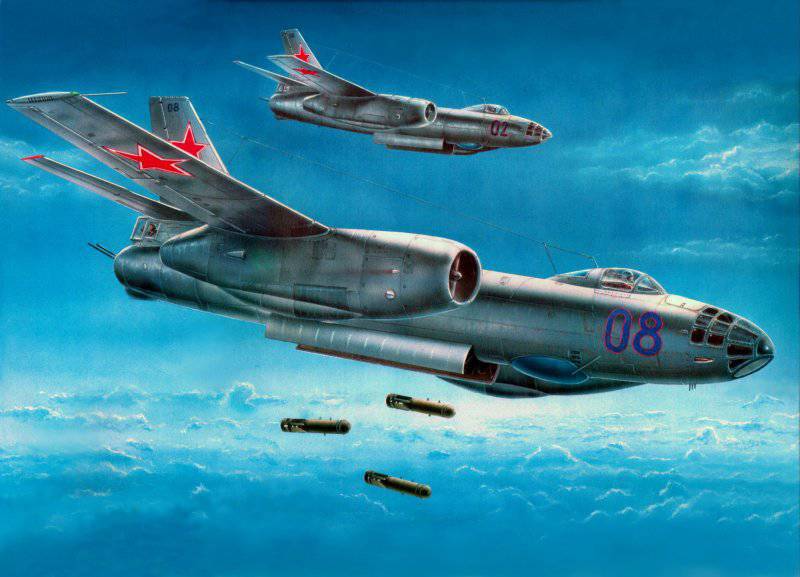
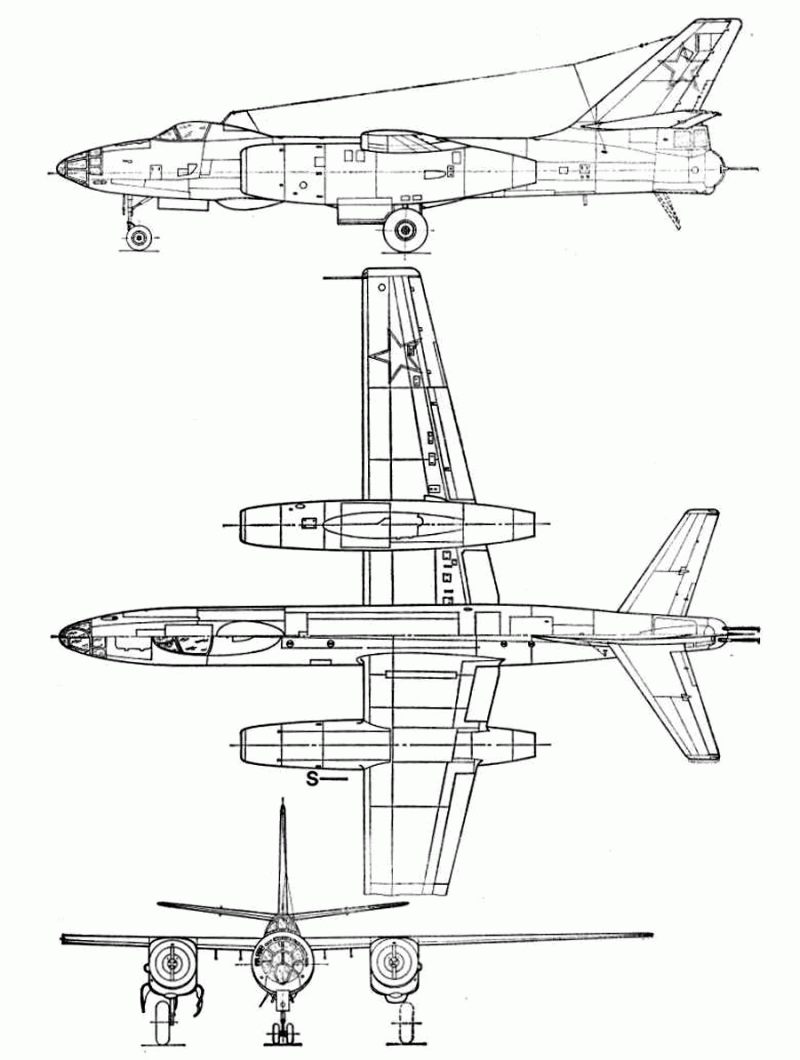
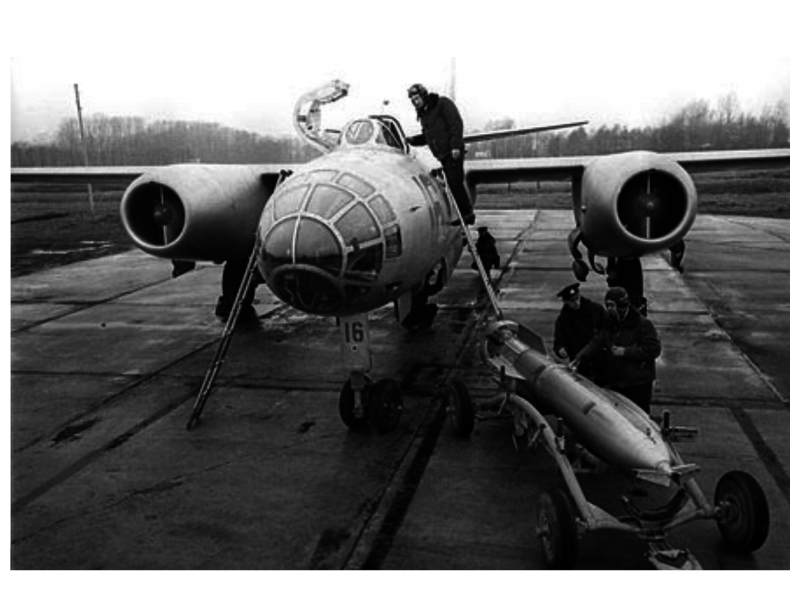
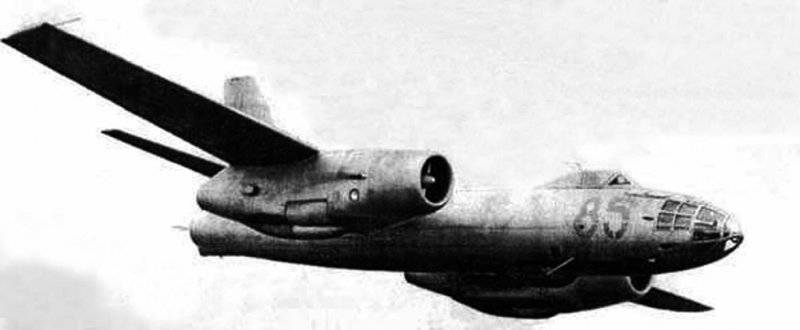
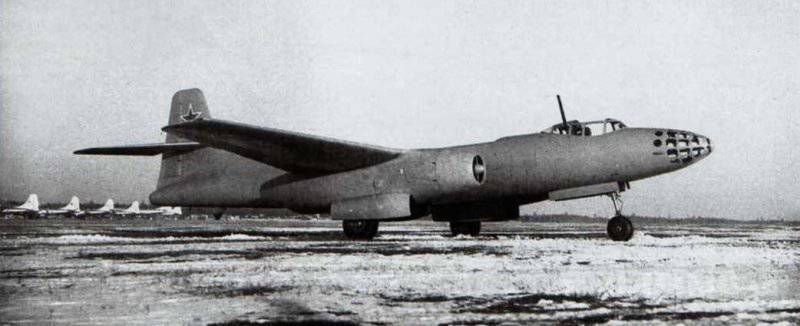
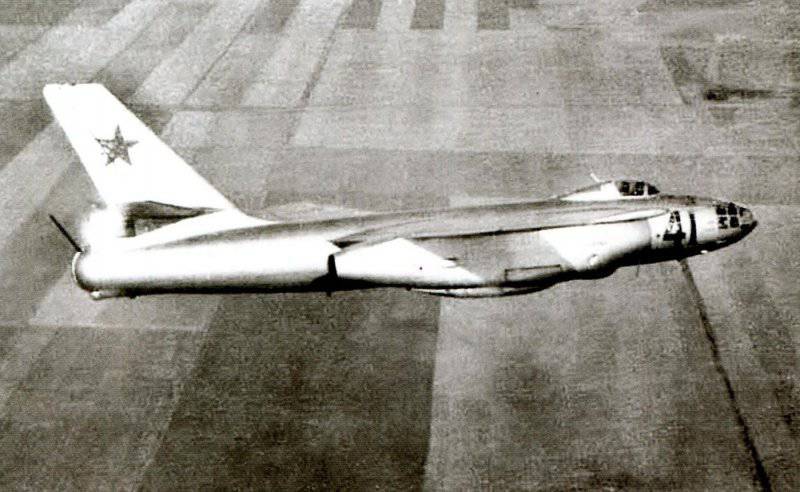
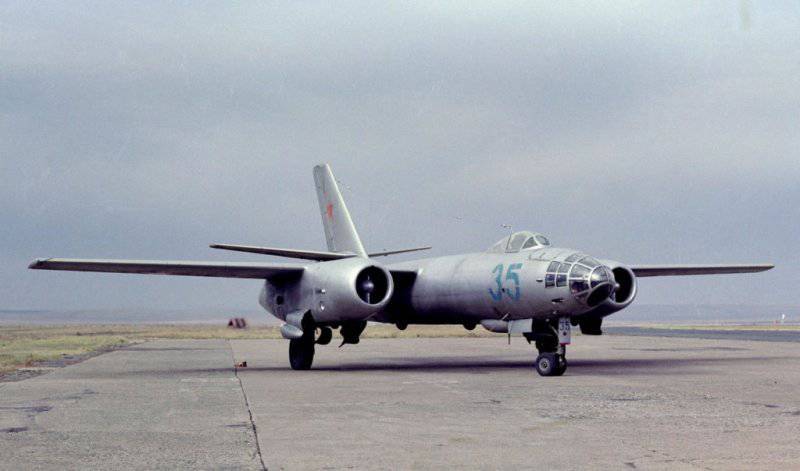
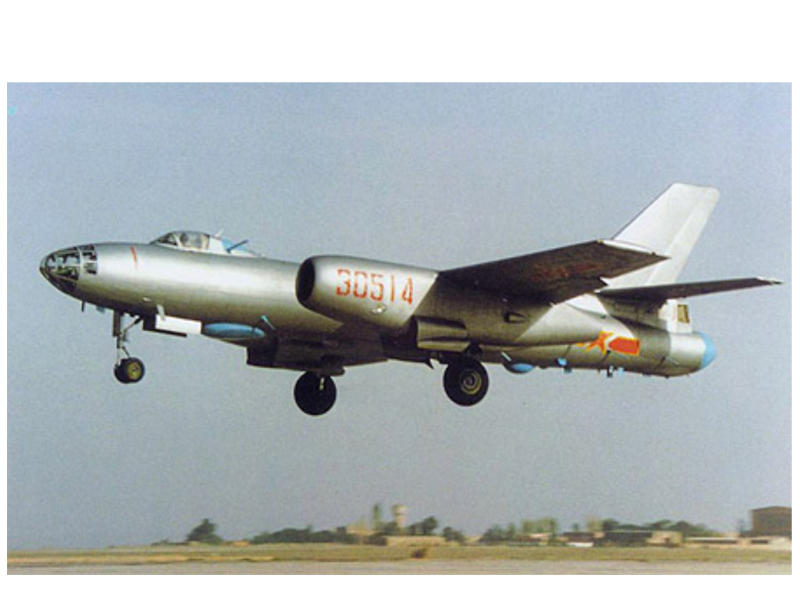
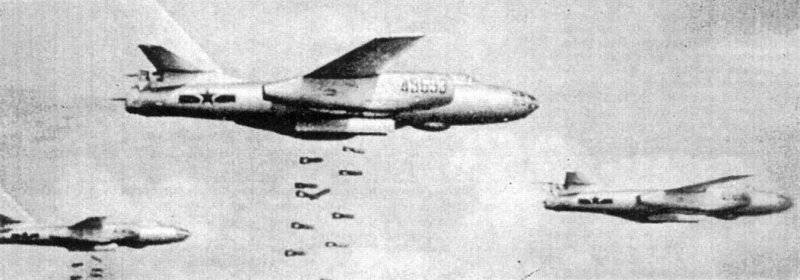
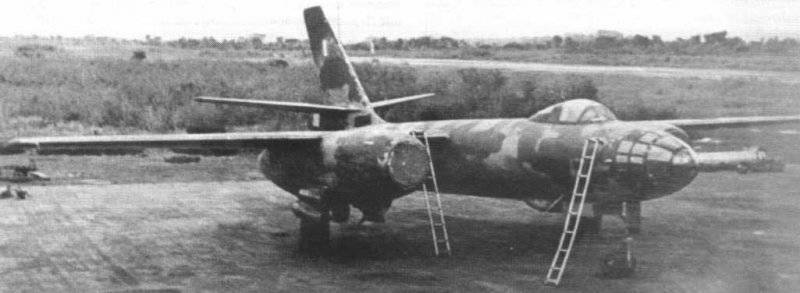
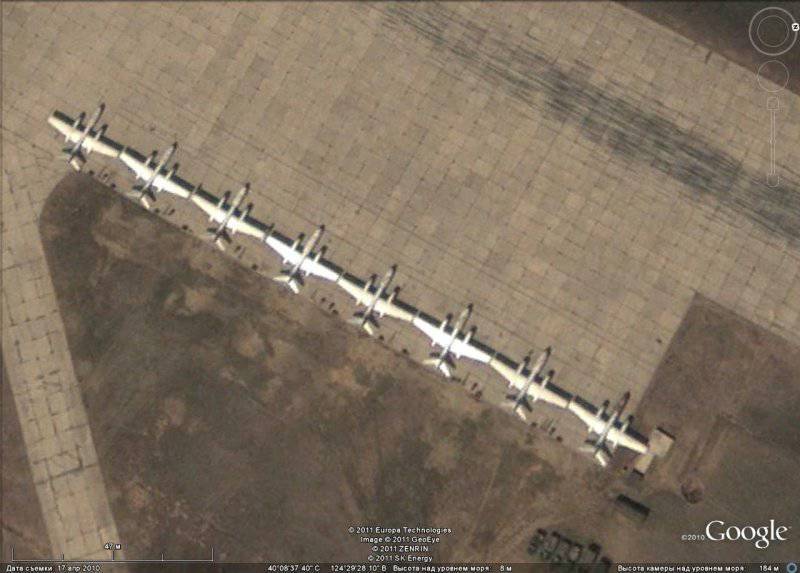
Information